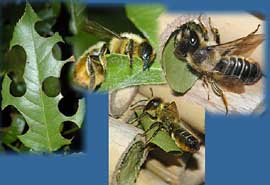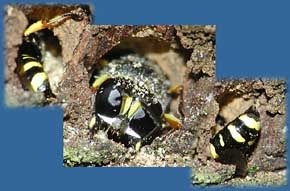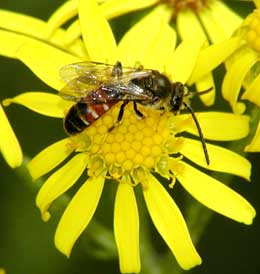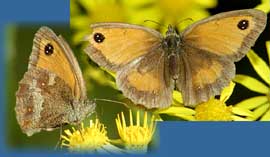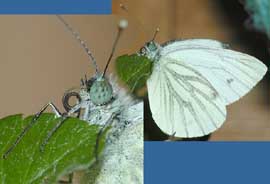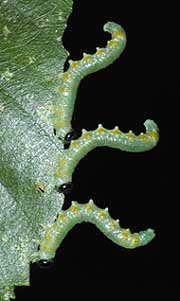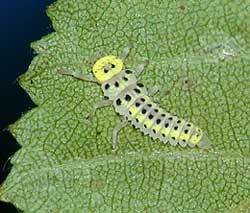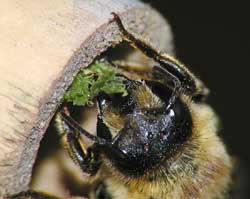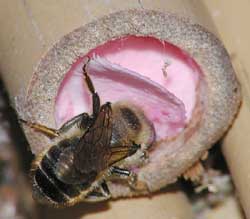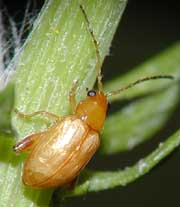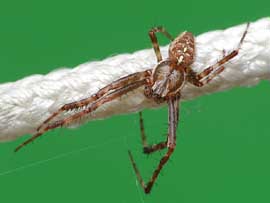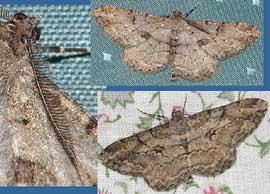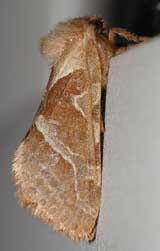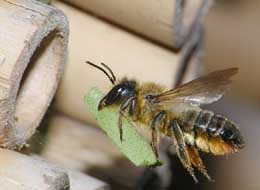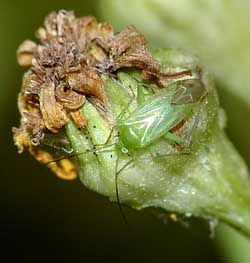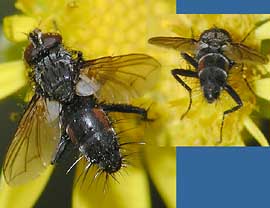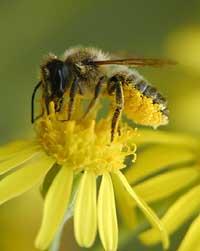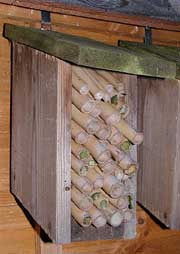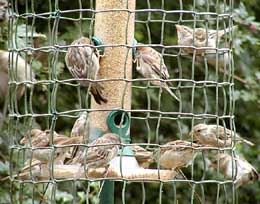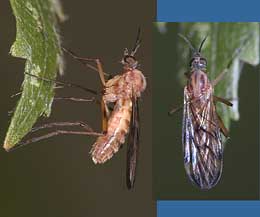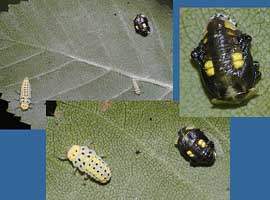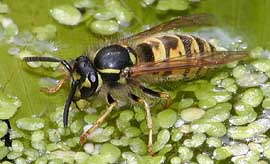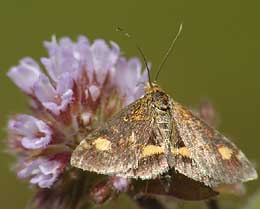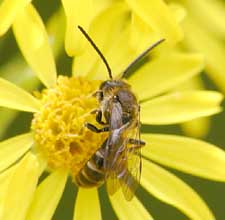Go to latest entry.....................................Go to previous entry19 August - Home Again! We returned on the weekend after some four weeks away in Devon and Cornwall. We had a very enjoyable break and now need time to recover! Later in the week I hope to put together a short holiday report with a few photographs of interesting creatures (and other things) encountered during the holiday. At the last minute we decided to leave our caravan down in Cornwall so we have to go back there during the school half-term holiday at the end of October! As predicted, the garden turned into a jungle in our absence - a job to be dealt with over the next few days.
The bamboo tubes that were used for the first time last year are receiving a great deal of attention and much of the activity has been taking place right in front of us as we relax on our deck. The bees are probably Megachile centuncularis, the most common of the leaf-cutters. When a bee has selected a suitable leaf she clings to the edge using mainly her legs. Then, using her jaws like a scissors she cuts the disc, measuring 10-12mm across, in just a couple of seconds and folds it over as she cuts. The lower image shows a tube that is already filled and sealed. Looking back at last year's diary I see that their activities were spotted on our return from Cornwall on the 21 August - perhaps I need a webcam to check on them while I am still away! The log in the pond is the venue for more nest building, this time by a solitary digger wasp. the pile of 'chippings' below the hole (about 6mm across) showed that it's efforts had started before our return, It was very busy this afternoon, and I was surprised to see it busy at 11pm last night. I have not been able to capture an image of it out in the open as yet, but these three images give a general idea of its appearance. It looks as though it could be a species similar to Ectemnius cephalotes.
Another possible bee or wasp was spotted on the Ragwort plant that is in full bloom now. I have not yet tried to ID this one. The centre of the flower measured about 8-9mm across.
The weather is very warm at the moment and we are seeing some butterfly activity, including this rather ragged Gatekeeper butterfly, feeding on the Ragwort.
This Green-veined White butterfly (Pieris napi) spent a long time resting in the shade this afternoon, very close to the Leaf-cutters.
Tonight I spotted the return of saw-fly larvae to the Birch tree, for the third year running. A check of the tree uncovered just one small branch affected with 12 individuals seen. These look similar to the sawflies that I saw on the Birch last year, but they do not have any black markings. John Grearson(of Ashton Keynes), who has a special interest in sawflies thinks that they could be members of the genus Nematus. The picture shows their characteristic tail-raising response when disturbed
Scanning the Birch leaves by torchlight did not reveal much, but I did spot this solitary larva on the underside of one leaf. It looks like a ladybird larva, although I'm not sure about its colouring.
While other bees were going off in all directions to collect pollen or leaves, the one pictured here simply flew less than a foot to a Pyracanthus plant for its leaves. The picture shows it chewing the edge of the leaf before sticking it to the sides of the tube. It is obvious that sometimes the chosen leaf does not develop the correct level of 'stickyness' as some are discarded and replacements collected to continue the task. Looking around the garden I have seen the results of leaf-cutter efforts on the leaves of not just roses and the Pyracanthus, but also the small Willow tree, Buddlea and even the Bamboos (only a few attempts on this!). While most of the time leaves are used to seal the cells, this bee obviously wanted to be noticed as it kept on bringing pink petal pieces. They must have been more fragile than the leaves - the ground has a scattering of pink as a result of discarded fragments. I still have to get a decent image of one of the bees returning with a load of pollen, thickly deposited on the hairs below their abdomens.
In sharp contrast to the frantic activity of the bees this tiny beetle, measuring less than 5mm long, has spent all day wandering a couple of branches on a Ragwort plant. I will have to add its ID later if I can.
I had to wait ages for this male spider to take a rest from its dashing around on the timber of the caravan shelter. The string it is posing on has a diameter of 5mm. ID still to be established.
A step backwards to last night when these two moths found their way into our bathroom. Although they appear to be the same species, the lower specimen has darker markings. They measure about 5cm across. A look in my guides suggests that they may be examples of the Pale Oak Beauty (Serraca punctualis).
This little moth perched on the lower frame of the monitor as I worked last night and tonight it is still here, to the side now. Again, it has still to be identified!
Before I forget, tonight there is no sign of the Saw-fly larvae on the Birch tree. Either they have taken a long processional walk or they have been eaten?
I spent a couple of hours watching this spot in the hope of getting a picture of it returning with pollen, but instead watched as it brought 25-30 pices of leaf instead!
A brief look at the Ragwort plant this morning revealed several capsid bugs like this one - I think it is a Common Green Capsid (Lygocoris pabulinus).
Some insects are pretty, some are design masterpieces, but I don't think this visitor to the Ragwort is either! I have yet to ID it.
The digger wasp photographed in it's burrow at the beginning of the week seems to have disappeared - I have not seen it today. I seem to have concentrated on the smaller visitors to the garden over the last few days, so I should say something about the birds. When I came home last weekend all the feeders in the garden were, not surprisingly, completely empty. They were filled straight away and now the birds are getting back to normal. While we were on holiday a report from the British Trust for Ornithology (BTO) suggests more than 20 million House Sparrows have been lost in the last 25 years, the South-East of England being especially affected. Well, I can report that our flock is doing well, with them virtually queuing up at the feeders. I have seen youngsters still begging for food during the last couple of days. While the Sparrows are doing well I am only seeing small numbers of Starlings (also suffering a big decline). I have seen a group of at least six blue tits at the bottom of the garden, showing interest in the apples and pears on my neighbour's trees and there have been three Dunnocks (1 adult, 2 juvenile) under the Hawthorn quite frequently this week. Only one Blackbird (the female) has made an appearance and I have only seen a Robin once (although I'm told that it has been here frequently while I was away). Before our holiday a pair of Chaffinches were regular visitors to the Sunflower kernel feeder, but I have not seen them so far this week. This morning we spent some time watching two hawks spiralling in a thermal high up over the house. Several times they seemed to be sparring (or playing?) I'm afraid I could not be sure what sort they were. There was also a high-flying flock of House Martins.
I have managed to ambush a Leaf-cutter bee as it collected pollen and nectar from a Ragwort plant. You can see how the hairs under its abdomen have become a mass of pollen as they are rubbed against the stamens of the flowers. Having lined part of the bamboo tube with leaves, the pollen and nectar will be used to make 'bee bread' on which she will lay a single egg. It will then be sealed in by more leaves before another cell is constructed in front of it.
Having taken the close-ups of the leaf-cutter bees in action I am including this picture of one of the sets of bamboo tubes being used by them. They are mounted on the North side of the garden fence, just over 4ft from the ground.
I may have done very litle in the garden, but the Sparrows seem to be busy most of the time. This is a snapshot of some of the flock at the feeder this morning. At that moment I estimated at least 50+ between the feeder, the table, the peanut feeders and the ground. Yesterday I spotted a Collared Dove with a twig in its beak heading into the conifers.
Also very evident at the moment are numerous of these larvae ( already pictured on the 19th) and pupae. The top left image shows two larvae at very different stages of development, and a pupa. The lower image shows the same pupa this morning with a larva that has started pupating. I have not checked its progress tonight as yet.
A frequent sight through the summer is the visit of wasps visiting the pond to drink. Their visits are brief and for once I was there with my camera. As this one flew off there was a glint of sunshine from a drop of water suspended under the head. Was it taking water back to the nest? I still see the wasps hunting amonst the plants, but they have now started to take more interest in sweet things as Summer draws on. Another pond related picture taken moments after the wasp left, this small moth was drinking the nectar produced by a flower of the mint plant. Again, my guide books seem to have missed this one out!
A bit of repetition in that I pictured this bee back on the 19th - I was able to get a bit closer this time. I see very few honey bees in the garden. Instead, it's bees like this one, the leaf-cutters (still active), and the bumble bees that are the frequent visitors to the flowers. |
|
